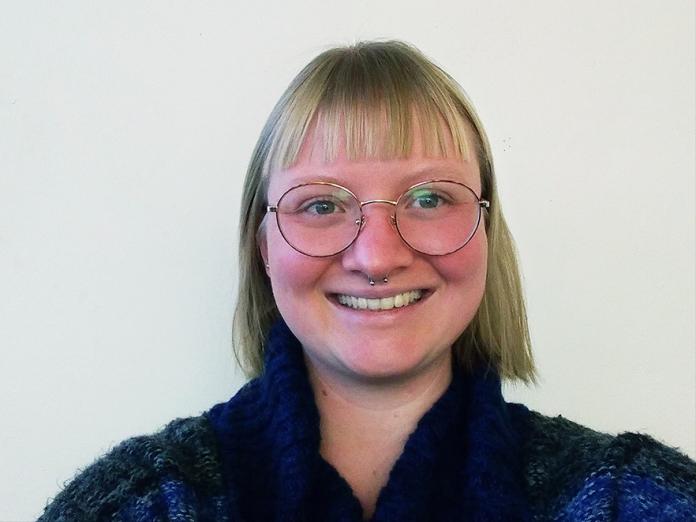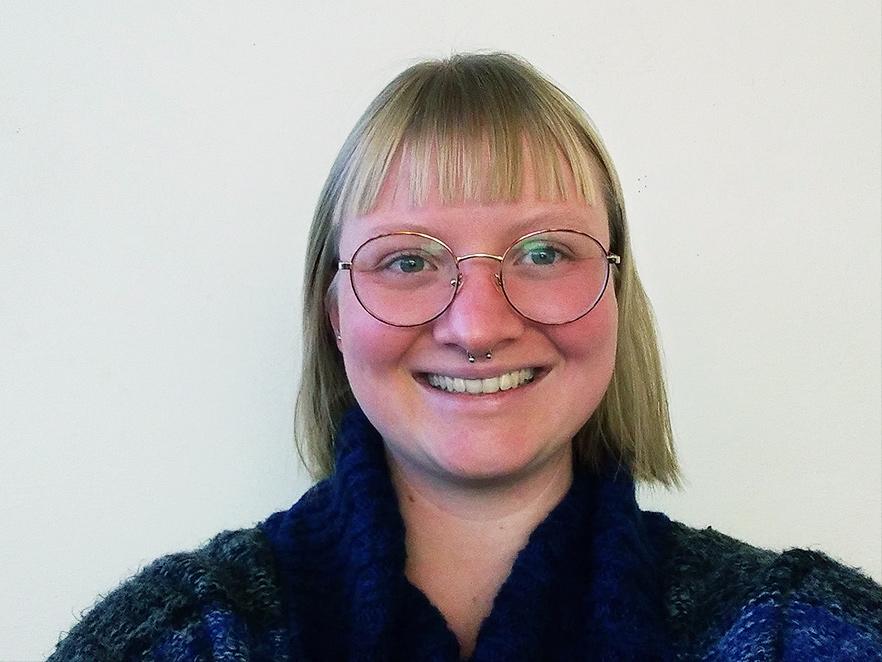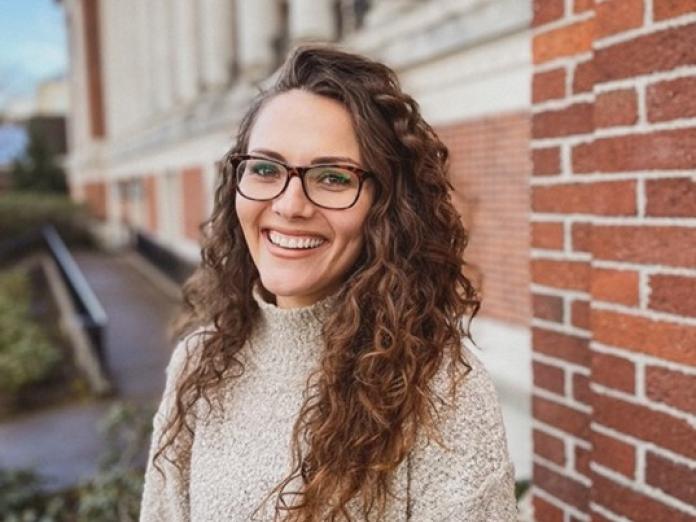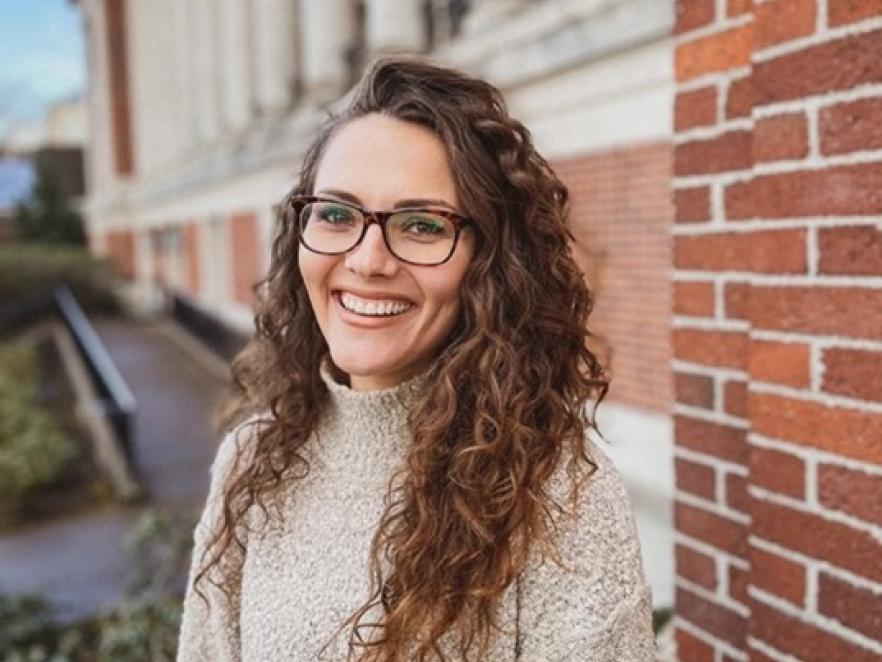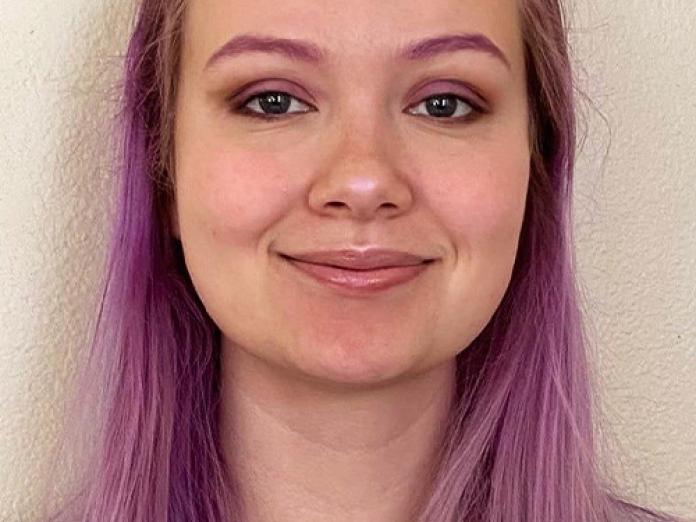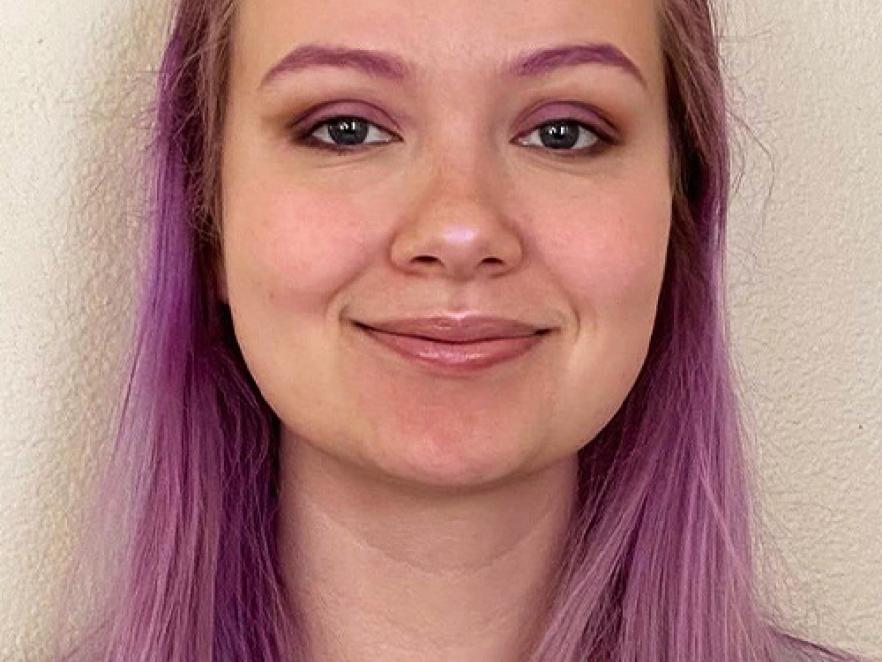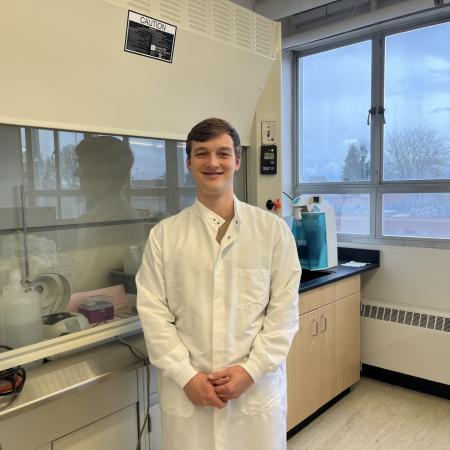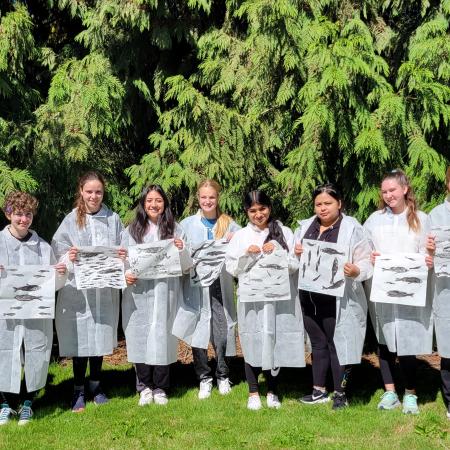Our graduates have gone on to successful careers in academia, industry, government agencies and private and public research labs. We are proud to have supported them in their careers.
Recently Graduated Grad Students
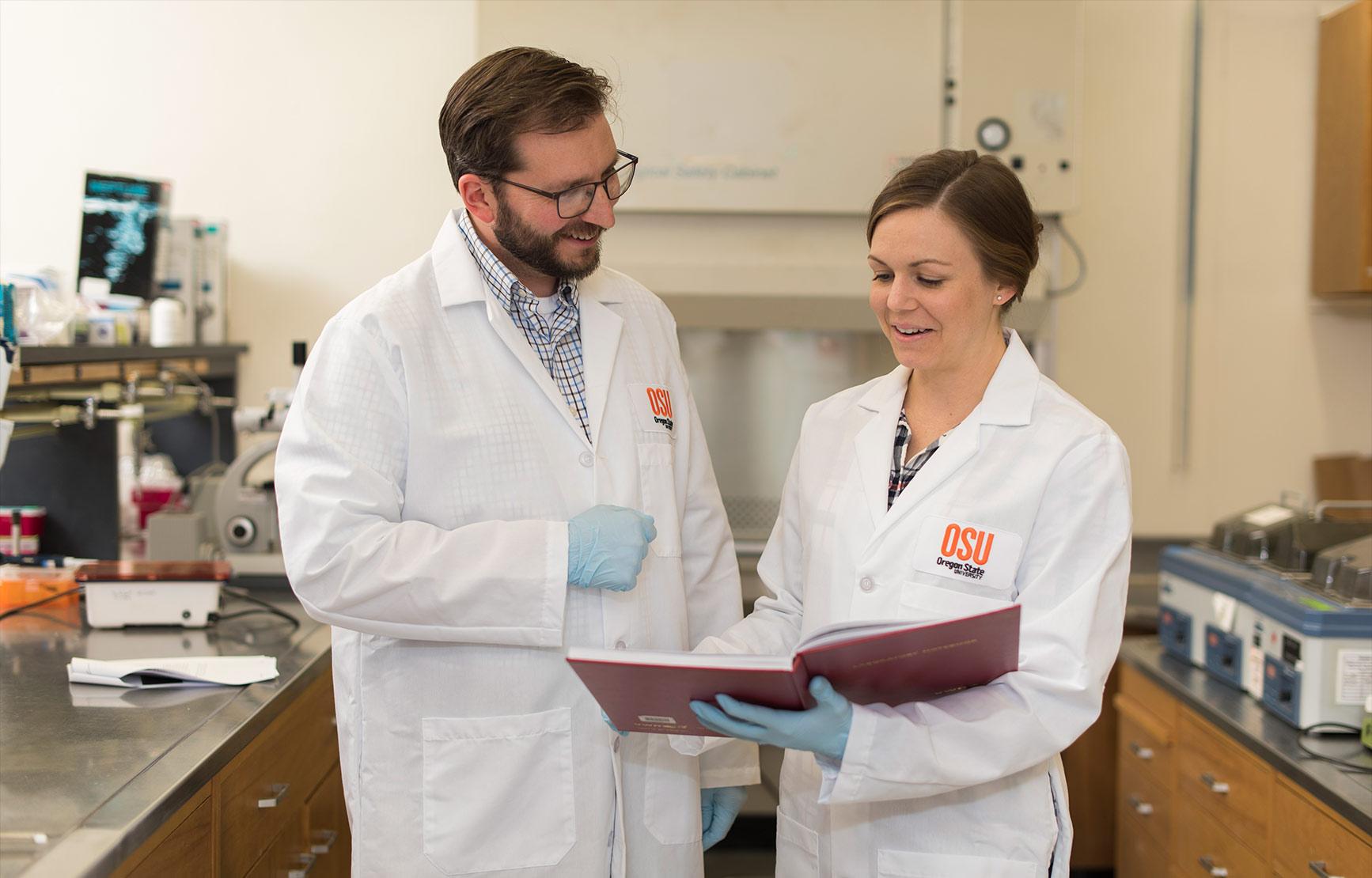
Courtney Armour working with Thomas Sharpton.
Our latest graduates
Our recent alumni are thriving!
Laura Nutter
Laura is now a Faculty Research Assistant in the Johns Lab in the College Veterinary Medicine at OSU.
My research focuses on identifying direct interactions between pneumococci and Influenza A Virus within biofilms.
Advisor: Dr. Hannah Rowe
Sarah Wolf
Dr. Wolf is now a Natural Resource Policy Fellow with Oregon Sea Grant, working for The Surfrider Foundation.
My research has focused on the microbiology and biochemistry of shallow marine ecosystems entering hypoxic states. In conjunction with Dr. Francis Chan (Integrative Biology), I performed experiments to test mechanistic models that will help us understand the rate of oxygen loss in systems experiencing oxygen stress.
Advisors: Dr. Steve Giovannoni and Dr. Francis Chan.
Jessica Büser-Young
Dr. Büser-Young is now a Research Associate in the Colwell Lab of the College of Earth, Ocean, and Atmospheric Sciences at OSU.
My research focuses on defining the microbial diversity of the subsurface within glacial outwash ponds, and the role the microbes play in global element cycling. My aim is to strengthen our understanding of the link between iron redox processes and anaerobic oxidation of methane.
Advisor: Dr. Rick Colwell.
Emily Schmeltzer
Dr. Schmeltzer is now a Biologist with the Eastern Ecological Science Center at Patuxent Wildlife Research Refuge in Maryland.
I use metagenomics and bioinformatic tools to research microbial ecology, specifically the roles of viruses and bacteria in response to increasing anthropogenic stressors in marine and terrestrial environments.
Advisor: Dr. Rebecca Vega-Thurber.
Erica "Rickie" Ewton
Rickie is now a Ph.D candidate in the Graduate School of Oceanography at the University of Rhode Island and received an Emerging Coastal Leader award for 2024.
My research interests lie in marine microbiomes and microbial ecology. My graduate work focuses on analyzing data collected from bleached corals surrounding the island of Mo'orea, which is located near Tahiti. Using three years of data collected from over 300 corals, I will test whether certain microbiomes impact the ability of corals to resist and recover from bleaching; this will advance our understanding of how the interplay between various coral reef components impacts the ecosystem services of a marine system.
Advisor: Dr. Andrew Thurber.
Dr. Hannah Kehlet-Delgado
Dr. Kehlet-Delgado is now a Postdoctoral Research Associate in the Friesen Lab at Washington State University.
I am interested in the ecology and evolution of Vibrio bacteria, particularly those associated with shellfish, as Vibrio species can cause disease in shellfish. In one project, I am investigating the dynamics of Vibrio populations and the overall microbial communities within shellfish hatcheries in relation to disease events and changes in abiotic factors. In another project, I am sequencing draft genomes of Vibrio isolates and conducting comparative genomic analysis to understand gene differences between isolates.
Advisor: Dr. Ryan Mueller.
Dr. Grace Klinges
Dr. Klinges is now a Postdoctoral Researcher at the Mote Marine Laboratory & Aquarium.
Disruption of symbiosis by pathogens or abiotic stressors is correlated with disease events, which are a major cause of coral mortality in tropical reefs worldwide. I study an obligate intracellular parasite within Rickettsiales that is correlated with decreased coral health and stimulated by excess nitrogen in the form of nutrient pollution. By probing the newly-assembled genome of this organism, I hope to discover a genetic basis for these effects on coral health. Additionally, I will use transcriptomics to assess the effects of this parasite on the coral immune system during nutrient-enriched tank experiments.
Advisor: Dr. Rebecca Vega-Thurber.
Dr. Rebecca Maher
Dr. Maher is now a Postdoctoral Fellow at Friday Harbor Laboratories and an Ambassador for the The National Microbiome Data Collaborative.
My Ph.D. research as a NSF Graduate Research Fellow involved studying how local and global stressors alter the coral host and its associated microbial community. I investigated how stressors such as fish predation, thermal stress, and nutrient enrichment act synergistically, additively, or antagonistically to alter the coral microbiome. In particular, I am interested in using multivariate statistical techniques to describe changes in the ecology of microbial communities.
Advisor: Dr. Rebecca Vega Thurber.
Dr. Adriana Messyasz
Dr. Messyasz is now a Bioinformatics Specialist at the Genomics Center of the New Jersey Medical School, Rutgers University.
I am interested in the role of bacteria and viruses in coral reef ecosystem health. I use metagenomics and amplicon sequencing to identify changes in viral and microbial diversity and abundance in healthy, bleached, and nutrient-enriched corals. I have assembled the draft genome of a putative coral giant virus and I am identifying viruses present in turf algae and fish (Stegastes nigricans) that interact with coral colonies. Overall I want to know what kinds of microbes are transmitted around the coral ecosystem and the types of viruses that play important roles in coral health.
Advisor: Dr. Rebecca Vega Thurber.
Dr. Stephen Noell
Dr. Noell has a Postdoctoral Research Fellow position at the University of Waikato in New Zealand, where he will be studying microbial communities on Mt. Erebus, the largest volcano in Antarctica.
I am studying the broad topic of how bacteria in the ocean interact with dissolved organic matter. I am specifically interested in studying the metabolism, substrate range, and transport kinetics of the most abundant group of marine bacteria, SAR11. I am doing this using a range of techniques, from radiolabeled uptake experiments to mass spectrometry. I am also looking at differences in gene regulation strategies between groups of bacteria in the ocean, as well as why these bacteria employ the strategies they use.
Advisor: Dr. Steve Giovannoni.
Dr. Bryce Penta
Dr. Penta is now a Senior Data Scientist at Enova in Chicago.
I am interested in the role of phytoplankton physiology on marine biogeochemical cycles. Currently I am studying phytoplankton physiological responses during acclimation to deep mixing events in the ocean. I plan to extend my research to investigate the contributions of various phytoplankton groups, such as mixotrophs (phytoplankton that can both photosynthesize and consume organic carbon), on ecosystem production.
Advisor: Dr. Kimberly Halsey.
Dr. Corbin Schuster
Dr. Schuster is now an Assistant Professor of Biology at Heritage University.
I am interested in utilizing zebrafish as a biomedical model to further investigate immunological mechanisms that occur when fish are exposed to parasites, such as Pseudoloma neurophilia, and other pathogenic organisms.
Advisor: Dr. Michael Kent.
Priyanka Singla
Priyanka is now a Research Associate with Molecular Testing Labs in Washington.
I am interested in studying the effects of certain microbes on human health. My research focuses on the microbiome-gut-brain axis, and more specifically on the impact of the gut microbiome on behavior.
Advisor: Dr. Maude David.
Dr. Winni (Lu) Wang
Dr. Wang spent a year as a Sea Grant Knauss Marine Policy Fellow, and is now a Biologist with the National Oceanic & Atmospheric Administration.
Seagrasses are critical coastal ecosystems that provide goods and services including stabilizing sediments, serving as a habitat for coastal organisms and nursery fishes, and partaking in nutrient cycling and carbon sequestration. Seagrass-associated microbes play a direct role in regulating nutrient cycling and seagrass health. My research aims to elucidate changes in carbon cycling and shifts in the microbial communities of seagrasses in light of eutrophication and ocean acidification.
Advisor: Dr. Ryan Mueller.
Jack Williams
My project is an investigation of the pangenome of the SAR92 clade of heterotrophic marine Gammaproteobacteria. The SAR92 clade is known to be globally distributed in the epipelagic zone with higher abundance in coastal zones and has recently been tied to the carbon cycle via laminarin (a complex polysaccharide) metabolism. I hope to identify specific variations in the genome that leads to SAR92 inhabiting such a wide range of marine environments.
Advisor: Dr. Steve Giovannoni.
Dr. Courtney Armour
Dr. Armour is now a Postdoctoral Research Fellow in the Schloss lab at the University of Michigan.
The goal of my research is to understand how the complex community of microorganisms that inhabit the intestines, known as the gut microbiome, influence vertebrate health and evolution. The primary aims of my research are: to determine (1) which microbiome functions consistently stratify healthy and diseased humans, (2) which microbiome functions are conserved across mammals, and (3) whether evolutionarily conserved microbiome functions are critical to health. Overall, this research will provide insight into the importance of specific microbiome functions to maintaining host health and will highlight their potential contribution to the evolutionary fitness of vertebrates
Advisor: Dr. Thomas Sharpton.
Dr. Kyle Asfahl
Dr. Asfahl is now the Managing Director of the Microbial Interactions & Microbiome Center at the Howard Hughes Medical Institute, University of Washington.
My current research focuses on the structure and evolution of bacterial regulatory networks using the opportunistic human pathogen Pseudomonas aeruginosa as a model organism. I am particularly interested in the mechanisms underlying the evolution of cooperative and competitive traits governed by cell-to-cell communication in bacteria, a process generally referred to as “quorum sensing”. The goal of my research is not only to obtain critical understanding of bacterial pathogenesis strategies important in clinical settings, but also to gain fundamental insight into the forces driving evolution at the molecular level.
Advisor: Dr. Martin Schuster.
Dr. Lmar Babrak
Dr. Babrak is now a Research Scientist at the Swiss Federal Institute of Technology (ETH) in Zurich, Switzerland.
I enjoy examining the molecular and cellular basis of microbial pathogenesis. Here is a quote from Dr. Seuss that exemplifies my thoughts on the future: "You have brains in your head. You have feet in your shoes. You can steer yourself in any direction you choose. You know what you know, you are the person who will decide where you go."
Advisor: Dr. Luiz Bermudez.
Kristina Baker
CyTOF Technician at Oregon Health & Science University
My research will use omics to study microbial communities in lagoons on the northern coast of Alaska. Seasonal shifts in salinity, temperature, freshwater runoff, and increasing permafrost thaw are all potential factors in shaping these communities. This is part of a larger, Long Term Ecological Research (LTER) study aimed at understanding how these changing factors affect the estuarine food webs.
Advisor: Dr. Byron Crump (CEOAS).
Dr. Saeed Banalas
Dr. Banalas is now an Assistant Professor at Majmaah University in Saudi Arabia.
Our research focus is on understanding the molecular mechanism of C. perfringens sporulation, spore germination, and spores resistance. My specific aim in my PhD research is to determine the machinery system of spore germination of spores of C. perfringens food poisoning and non-food-borne gastrointestinal (GI) diseases strains.
Dr. Damien Barrett
Dr. Barrett is now a postdoctoral scholar at the University of Mississippi.
The parasite Ceratonova shasta is a major cause of mortality in Pacific salmon and trout. Resistance to this important pathogen varies markedly among fish populations. My work is aimed at finding the genetic loci responsible for resistance and determining if the resistance mechanism is conserved among different species of salmon and trout. I am currently employing a combination of transcriptomics, genetic mapping, and population genetics to accomplish this goal.
Advisor: Dr. Jerri Bartholomew.
Dr. Lauren Brooks
Dr. Brooks is now an Assistant Professor of Biology at Utah Valley University.
An alarming number of people in the U.S. become sick each year from exposure to contaminants resulting from under- or untreated sewage. Current monitoring protocols enumerate indicator bacteria without providing any source information, leaving those interested in remediation without a starting point. For the past three years, I have worked in Long Island Sound to identify sources of indicator bacteria using molecular methods for species identification as a starting point. This experience has provided me with many insights into the field of source tracking as well as shown me the need for these tools to be developed to the point of standardized implementation. I am investigating the properties of these markers and their potential for use in future studies as well as try to improve on weaknesses in the current tools for source identification. I hope to continue improving source tracking techniques throughout my dissertation as well as afterward by continuing research in this field by applying these methods to impacted sites.
Advisor: Dr. Katharine Field.
Dr. Nathan Brown
Dr. Brown is now the Chief Science Officer and Co-Founder of Parallel Health.
Bacteriophages on Earth outnumber the stars in the universe and encode the largest amount of genetic diversity on Earth, which are only two of many reasons that I think they are intrinsically interesting to study. Beyond their intrinsic value, bacteriophages contribute many practical tools and techniques to molecular biology. I am interested in building next-generation molecular biology tools by exploiting some of the countless novel enzymes encoded in bacteriophage genomes.
Advisor: Dr. Theo Dreher.
Dr. Samuel Bryson
Dr. Bryson is now a Computational Biologist at Phase Genomics.
My research focuses on understanding marine microbial systems at scales from individual populations to whole communities. I have been developing proteomic stable isotope probing (proteomic SIP) as a tool to quantify dissolved organic carbon assimilation by specific microbial populations. By using this data in combination with whole community genomics and proteomics, I am connecting the substrate preferences and physiological factors that define the ecological roles of individual populations to whole community population dynamics.
Advisor: Dr. Ryan Mueller.
Jessica Chinison
Lab Technician, City of Hope Medical Center, Los Angeles
I am from Tahiti, French Polynesia. I am working on understanding Mycobacterium avium subspecies hominissius protein secretion, determining their functions and involvement in human pathogenicity.
Advisor: Dr. Luiz Bermudez.
Michael Dobie
Works in the Lab at Oregon Freeze Dry
My area of research is focused on nitrification, a vital part of the greater nitrogen cycle. I work with the nitrite oxidizing bacterium Nitrobacter hamburgensis and am interested in how altering components of its growth media effect gene expression. Transcriptomics and other aspects of molecular biology are central to my research.
Advisor: Dr. Luis Sayavedra-Soto (Botany and Plant Pathology).
Connor Driscoll
Data Analyst, Michael Gale Jr. Lab, University of Washington
My research focuses on the role of viruses in in cyanobacterial blooms. Harmful algal blooms (HABs) are potential threats to freshwater drinking sources that often consist of the toxic cyanobacteria Microcystis or Anabaena. My interest is in discovering new viruses for these hosts as well as understanding host-virus evolutionary dynamics.
Advisor: Dr. Theo Dreher.
Dr. Jamie Everman
Postdoctoral Fellow at the National Jewish Hospital in Denver
Infectious bacterial pathogens and zoonotic diseases are where my research interests lie. I am fascinated by the mechanisms that pathogens have evolved to manipulate our immune system, and my goal is to be able to work with and conduct research on both the bacterial and the human factors that are utilized during the progression of infectious diseases.
Advisor: Dr. Luiz Bermudez.
Dr. Nerissa Fisher
Ph.D. student, University of Technology in Sydney, Australia
Phytoplankton physiology is a subject I find most intriguing and the focus of my research. These photosynthetic unicellular organisms are crucial for supporting marine and terrestrial life by producing approximately 50% of the oxygen in the Earth's atmosphere making them the most important global primary producers. In addition to being the base of all aquatic food webs, phytoplankton are also key players in the microbial loop, biogeochemical cycling, and climatic controls. The components that limit phytoplankton growth are light and nutrients both of which are affected by global climate change. Studying phytoplankton is important to understand how they will respond to climatic changes because global oxygen levels are dependent on phytoplankton biomass. My current research focuses on a marine diatom, Thalassiosira pseudonana, and its response to light limitation more specifically looking at how the allocation of energy to converted into cell biomass. My main goal is to gain further insight into the physiology behind this diatom species' response to different light levels and continue working in this field to better understand phytoplankton dynamics.
Advisor: Dr. Kimberly Halsey.
Garrett Holzwarth
Microbiologist, Two Towns Ciderhouse, Corvallis
I am interested in industrial and biotechnological uses of the yeast Saccharomyces cerevisiae. Our lab has engineered a strain that produces the UV-absorbent compound gadusol. Gadusol is found in many marine organisms and has potential to serve as a sunscreen which could reduce the risk for skin cancer. While gadusol is not a normal yeast metabolite, it is made from a central yeast metabolic intermediate. My research focuses on altering yeast's metabolic pathways to increase production of gadusol, and possibly valuable gadusol derivatives as well.
Worked with Dr. Alan Bakalinsky (Food Science).
Claire Howell
Washington Department of Fish and Wildlife
I am working on developing a monitoring protocol for the freshwater fish parasite Ichthoyophthirius multifiliis (Ich). I will be examining the relationship between parasite density, water temperature and salmonid disease rates in the Klamath River system. This project is in collaboration with the Yurok tribe and CA/NV Fish Health Center.
Advisor: Dr. Jerri Bartholomew.
Kalyn Hubbard
Zebrafish Technician at NemaMetrix, Eugene, Oregon
In collaboration with the Confederated Tribes of the Warm Springs of Oregon Reservation, USFWS, and ODFW, our goal is to discover the role of pathogens (such as the parasitic myxozoan, Ceratonova shasta) in juvenile and pre-spawn mortalities of adult Spring Chinook salmon. We will use qPCR analyses of both bi-weekly and longitudinal water samples, conduct sentinel fish exposures, and perform necropsies.
Advisor: Dr. Jerri Bartholomew.
Ian Humphreys
Ph.D. University of Washington Fred Hutchinson Research Cancer Center
I am interested in leveraging computational techniques to improve our understanding of microbial evolution. My work currently focuses on assessing the accuracy of 165 phylogenetic trees which are an integral tool used to infer evolutionary relationships between members of microbial communities.
Advisor: Dr. Thomas Sharpton.
Michelle Jakaitis
Microbiologist, Idaho Department of Fish and Game
My research interest is in fish pathology, and I am focusing on the microbial aspects of disease, as well as disease prevention, management, and risk assessments in hatcheries and wild environments. My goals are to continue pursuing these interests either through a research lens or of that of a fish pathologist. I came from the University of Colorado at Boulder with a degree in Molecular, Cellular, and Developmental Biology. At the same time, my long-standing fascination with fish drove me to supplement my academic career with marine biology internships. My current project, investigating disease dynamics between hatchery fish and wild fish, aligns these interests and allows me to combine the elegance and versatility of molecular biology with time in the field; specifically exploring the Willamette River Basin.
Advisor: Dr. Jerri Bartholomew.
Bailey Keefe
Research Assistant Dr. Bermudez Lab, Vet Med, OSU
My research interests include learning more about how pathogens cause disease in both humans and animals. The project I will be working on is looking at the host-microbe interaction between Mycobacterium avium and human respiratory epithelial cells. Specifically, I am looking at their ability to form microaggregates and identifying the proteins and their function used in this process.
Advisor: Dr. Luiz Bermudez.
Dr. Brandon Kieft
Postdoc at University of British Columbia
I am interested in how matter and energy flow through large biological systems, namely the microbial systems that connect the continents to the seas. I am using -omics to study the turnover of terrestrially-derived organic matter by bacterial communities in estuaries and coastal oceans. Findings from this research should provide a better understanding of the composition and function of heterotrophic bacterial communities that "eat" and respire all the carbon that is produced on land but washes to the sea.
Advisor: Dr. Ryan Mueller.
Dr. Nicole Kirchoff
Microbiome Data Scientist at Rebiotix
Microorganisms that occupy the vertebrate gastrointestinal tract play an important role in determining their vertebrate host's health. However, it is unclear how the influence of microbes on host health is related to the ecological success of vertebrates. I use a salmonid model (i.e., rainbow trout) to quantify the contribution of gut bacteria to the ecological fitness of fishes and how climate change perturbs these contributions. Ultimately, my work will improve the management and conservation practices of fisheries.
Advisor: Dr. Thomas Sharpton.
Dr. Scott Klasek
Postdoctoral Associate, Department of Plant Pathology, University of Minnesota
Marine sediments are one of the earth’s largest sources of methane, a greenhouse gas. Consortia of methanotrophic archaea and sulfate-reducing bacteria in marine sediments consume up to 90% of this methane, so comparatively little reaches the overlying ocean. The microbial community response to methane flux from the subsurface is largely uncharacterized. I am using high-pressure enrichments and analyzing microbial communities in Arctic sediment samples to investigate how and where these microbes consume methane and how their communities change over time.
Advisor: Dr. Rick Colwell (CEOAS).
Dr. Zach Landry
ETH Zurich, Switzerland, Department of Civil, Environmental, and Geomatic Engineering
My research revolves around the use of combined single-cell genomics and culturing techniques as a means of acquiring data for metabolic reconstruction of numerically prevalent, but uncultured organisms from varying environments, including the upper mesopelagic zone of the open ocean. I am heavily interested in the applications of new technologies to environmental and applied microbiology, and in the future I would be interested in the design and development of technologies specifically intended for these fields.
Advisor: Dr. Steve Giovannoni.
Matthew Lewis
Research Associate, Anschutz Medical Campus, University of Colorado
My research focuses on intracellular pathogenic bacteria. The mechanisms allowing Mycobacterium to persist within macrophage and amoeba are of particular interest. I will employ microscopy, and molecular and immunological techniques to elucidate the host-microbe interactions in hopes of reducing disease.
Advisor: Dr. Luiz Bermudez.
Elizanette Lopez
Graduate Research Assistant, Oregon State University
Laboratory zebrafish (a high-throughput bio-medical model), are used in labs worldwide. A hot fish model developed by Dr. Justin Sanders allows zebrafish to host a mammalian parasite called Toxoplasma gondii. An important step in developing this model is to determine how common aquaculture infections affect zebrafish at high temperatures. My research aims to improve the zebrafish model by understand-ing immunological mechanisms within the organism, as well as characterizing specific infections (Mycobacterium chelonae and Pseudocapillaria tomen-tosa) to improve diagnostics.
Advisors: Dr. Michael Kent and Dr. Justin Sanders.
Kelsey McBeain
Lab Technician in Alyson Santoro's Lab, U.C. Santa Barbara
My research focuses on how prey nutrient levels affect predator fitness. By manipulating the lipid content of Dunaliella teriolecta, I can create energy- rich and energy-poor stock cultures. By feeding these prey separately to the predator (Oxyrrhis marina) in a two-step continuous culture, I will measure different aspects of predator fitness, such as ingestion and excretion rates as well as lipid concentrations of these predators. This work will help to understand how food web dynamics will transform in the face of ongoing climate change.
Advisor: Dr. Kimberly Halsey.
Katie McConnell
Lead Instructor, Wildlands Studies
I am interested in the roles microbial communities play in ecosystems. My work will focus on links between biogeochemical cycling, viral infection, and endosymbiotic dinoflagellates in overall coral physiology and reef health.
Worked with Dr. Andrew Thurber.
Dr. Ryan McMinds
Research Assistant Professor, College of Public Health, University of South Florida
I am interested in the evolution of symbiosis and inter-individual cooperation. More specifically, I study the interactions between corals and their microbial associates, an important and understudied facet of a globally endangered ecosystem, the coral reef.
Advisor: Dr. Rebecca Vega Thurber.
Dr. Eric Moore
Research Technologist at Los Alamos National Laboratory
Diatoms are among the most important phytoplankton. My research is focused on the behavior of diatoms. Using a wide variety of techniques, I am working to understand the ecology of the diatom life cycle and how diatoms interact with other microbes in the ocean.
Advisor: Dr. Kimberly Halsey.
Dr. Omran Muslin
Clinical Toxicologist, QUEST Diagnostics, Washington, D.C.
I study marine microbial communities, specifically SAR11, the most abundant marine bacteria known. I investigate their contribution to oceanic carbon cycling and focus on their interactions with the dissolved organic carbon pool. I use mass spectrometry to detect and quantify osmolytes that are produced in large amounts by most plankton cells making them an important component of the dissolved organic carbon pool. The streamlined metabolism of SAR11 cells includes specialized pathways for osmolyte oxidation. I have also developed methods for accurately measuring the natural concentrations of osmolyte compounds in the ocean surface near Bermuda.
Advisor: Dr. Steve Giovannoni.
Lauren Norris
Technician, Dr. Michael Kent, Oregon State University
More and more Zebrafish (Danio rerio) are being used as models in biomedical research. My research focuses on molecular diagnostic testing for Zebrafish pathogens, particularly the sensitivity and specificity of these tests.
Advisor: Dr. Michael Kent.
Juliette Ohan
Los Alamos National Laboratory
Microbial induced calcite precipitation (MICP) is a technique that induces (introduced or native) microbes to secrete CaCO3 in soils, thereby reducing soil porosity, stiffening and strengthening the soil mass, altering the response of the internal fabric to stress changes, and increasing the dilative tendency upon shear. I am investigating microbial enrichment strategies in model soil columns and later moving to larger field scale experimentation to induce precipitation and characterize the soil’s microbial diversity, distribution, and production capacity for long-term soil stabilization.
Advisor: Dr. Rick Colwell (CEOAS).
Michelle Pombrol
Novogene Project Coordinator, Genome Sequencing Sacramento
Phytoplankton are key drivers of ocean biogeochemical cycling and form the base of the marine food web. I am using RNA-Seq to explore how the model diatom Thalassiosira pseudonana differentially allocates photosynthetic energy under different light-mediated growth rates. A better understanding of these organisms’ metabolic strategies may lead to more refined climate change models and increase the feasibility of metabolic engineering for production of biofuels and other natural products.
Advisor: Dr. Kimberly Halsey.
Dr. Aimee Reed
Head, Fish Health Services, ODFW, Corvallis
My research in Biomedical and Veterinary Sciences focuses on viral diseases, their pathogenesis, and genetic characteristics. One project focuses on the investigations of Koi Herpes virus latency and reactivation of disease; a second project is investigating a novel viral disease of goldfish that may be associated with tumor development on the skin. My studies are providing interactions with both the Hatfield Marine Science Center and the Department of Pathology in the College of Veterinary Medicine and my intent is to continue incorporating these facilities into my future research of viral diseases of fishes.
Advisor: Dr. Ling Jin.
Tanner Robinson
Research Associate at BioFire Diagnostics, Utah
I am working on learning the ways in which Pseudomonas aeruginosa PAO1 populations adapt to increased cheater loads in quorum sensing dependent growth conditions. I am doing this through whole genome sequencing of isolates obtained from in vitro evolution experiments, creating mutant strains, and testing them under varying culture conditions.
Advisor: Dr. Martin Schuster.
Sean Roon
Fish Health Specialist, Washington Department of Fish and Wildlife
I have always been interested in epidemiology of disease, and more specifically, the survey and prevention of diseases. Furthermore, I am interested in discovering the behaviors of fish and wildlife leading to the spread of disease along with ecological factors aiding transmission.
Advisor: Dr. Jerri Bartholomew.
Dr. Stephanie Rosales
Postdoctoral Research, NOAA, University of Miami
My research focuses on the viral consortia and microbial communities associated with a marine mammals stranding event. I have identified known viral pathogens in harbor seal brains and two significant bacteria pathogens that have previously not been detected in marine mammal brains, using high throughput sequencing and bioinformatics. My data shows that bacteria Burkholderia and Coxiella burnetii were significant players in this harbor seal stranding event. I would like to determine the prevalence and disease progression of these bacteria in marine mammal populations.
Advisor: Dr. Rebecca Vega-Thurber.
Dr. Sasha Rose
Senior Scientist at INSMED Inc., New York City
My research interest is focused around the host microbe interaction of Mycobacterium avium and the host macrophage, which is the preferred cell type in the body that this pathogen resides in. Some of my current projects include understanding biofilm interactions with macrophages (which is drastically different than the free cell interaction), and looking into the mechanisms of resistance that M. avium has to host produced nitric oxide. I plan on staying in academia with my graduate degree and running a laboratory at a major research university.
Advisor: Dr. Luiz Bermudez.
Dr. Joe Sexton
ORISE, Postdoctoral Fellow, CDC, Atlanta
I study the evolution of bacterial social behaviors using the production of iron scavenging siderophores in Pseudomonas sp. as a model system. It is theorized that social conflict threatens any given cooperative behavior. Social cheaters, who can defect investment but still reap the benefits provided by the group lead to a burden on the population. This work will provide strong empirical data which can address the role of social conflict of such defectors in nature as well as human infections and contribute to our understanding of the evolution of social behaviors in general.
Advisor: Dr. Martin Schuster.
Dr. Prabhat Talukdar
Postdoctoral Research Associate, Washington State University
Dr. Talukdar is now a postdoc in Dr. Michael Konkel's lab at the School of Molecular Biosciences under the College of Veterinary Medicine at Washington State University, Pullman. He will be working with the molecular characterization of Campylobacter jejuni effector proteins and cellular response of host cells.
Advisor: Dr. Mahfuzur Sarker.
Dr. Dan Tanaree
The Craig lab focuses on (1) grass endophyte toxicity – the Neotyphodium coenophialum is a mutualistic symbiotic fungus living within tall fescue grass, granting the grass unusual resistance to drought, insects, and overgrazing. This, however, comes at a cost of potentially causing endophyte toxicosis in ruminants, a disease characterized by intolerance of heat and cold and spontaneous abortion of calves and foals. My research is an expression microarray based study of physiological and toxicological responses to endophyte toxicosis in cattle. (2) The second area is bioremediation of explosive compounds, which are frequently toxic and accumulate in soil. Previous research has indicated that the bacterium Sporanaerobacter acetigenes can tolerate extremely high concentrations of the explosive compound RDX and may be capable of breaking it down. I am assembling a draft genome of this bacterium utilizing high throughput sequencing. My goal after graduation is either continued research with a bioinformatics and genetics focus or something related to human health, possibly in medicine.
Advisor: Dr. Morrie Craig.
Laura Taggart-Murphy
Gnotobiology Technician University of Oregon
I am investigating mucosal immunity and resistance mechanisms to the myxozoan parasite, Ceratonova shasta, in rainbow trout. My focus is on the role of immunoglobin T (a mucosal immunoglobulin isotype unique to fish) during infection with C. shasta. I am also interested in characterizing the early and ongoing inflammatory response to different C. shasta genotypes, ad determining if an adaptive immune response provides protection against reinfection.
Advisor: Dr. Jerri Bartholomew.
Trang Nguyen
Postdoc at University of Southern California
My research is to evaluate the microbial and matrix regulators of protein degradation in soils as a controller of nitrogen turnover. I am interested in learning how soil proteins break down under different environmental conditions. Protein depolymerization was recently recognized as a critical rate-limiting step in the nitrogen cycle before any further mineralization or immobilization occurs. Extracellular protease activity and mineral surface structures are predicted to play an important role in this process. I hope to discover how forested soil environments with wide ranges of mineralogy and microbial composition, might contribute and characterize this bottle-neck in the nitrogen cycle.
Advisor: Dr. David Myrold (Soil Science).
Dr. Kevin Vergin
Consultant
I have worked in Steve Giovannoni’s laboratory for over twenty years studying marine microbiology. I am now in a Master’s program to learn statistical methods and am applying those methods to develop a bacterioplankton correlation network from nine years of samples from our study site near Bermuda. My main interest is in microbial ecology as applied to community formation and function in the marine environment.
Advisor: Dr. Steve Giovannoni.
Dr. Rory Welsh
Microbiologist, CDCP, Atlanta
My research focuses on an unusual group of predatory bacteria, Halobacteriovorax. Halobacteriovorax prey exclusively on a wide range of gram-negative bacteria including many known pathogens. My research aims to determine the ecological role of these highly motile bacterial predators in the microbiome of their host. I employ a wide range of methods and technologies utilizing culture dependent and independent techniques to study how cell-cell interactions impact microbial community structure and function.
Advisor: Dr. Rebecca Vega-Thurber.
Dr. Wei Wei
USDA/ARS Fresno, California
Our lab researches the molecular interactions between the bacterial pathogen Agrobacterium and plants. Agrobacterium causes the disease crown gall on many economically important crops, while simultaneously being the most common tool for making genetically modified crops. Agrobacterium does this by transferring single-stranded DNA and virulence proteins from the bacterium to the plant. My thesis research focuses on plant responses to a novel A. rhizogenes virulence protein, GALLS-CT, that is required for gene transfer to many host plants.
Advisor: Dr. Walt Ream.
Sofia Yusova
I am interested in the effects of climate change on Ceratonova shasta, a myxozoan parasite that infects salmonids on the Pacific Coast of North America. Specifically, my research will focus on relationships between river temperature and the dynamics of genetic variants of C. shasta, and how their phenologies may change under future climate contexts.
Advisor: Dr. Jerri Bartholomew.


